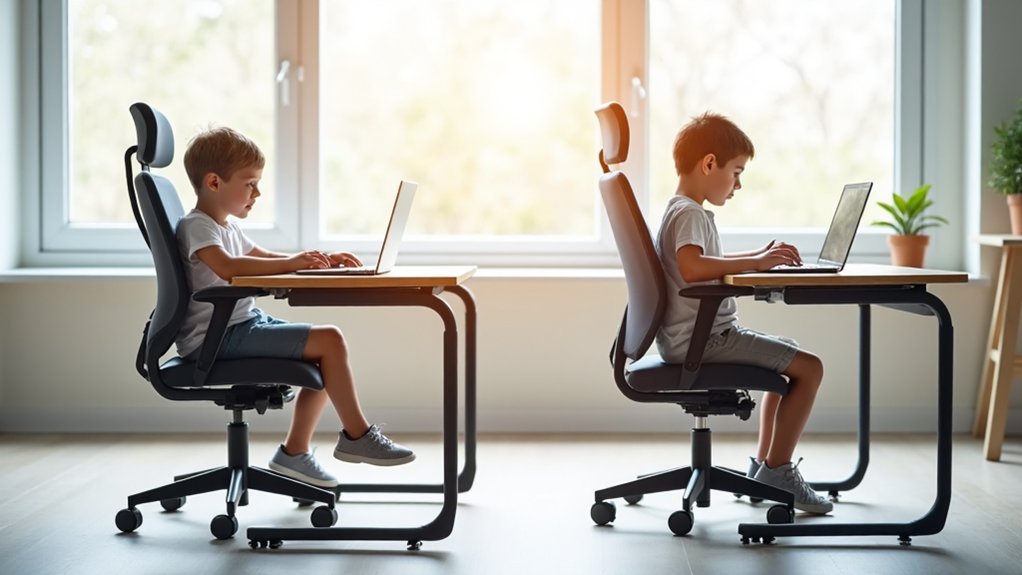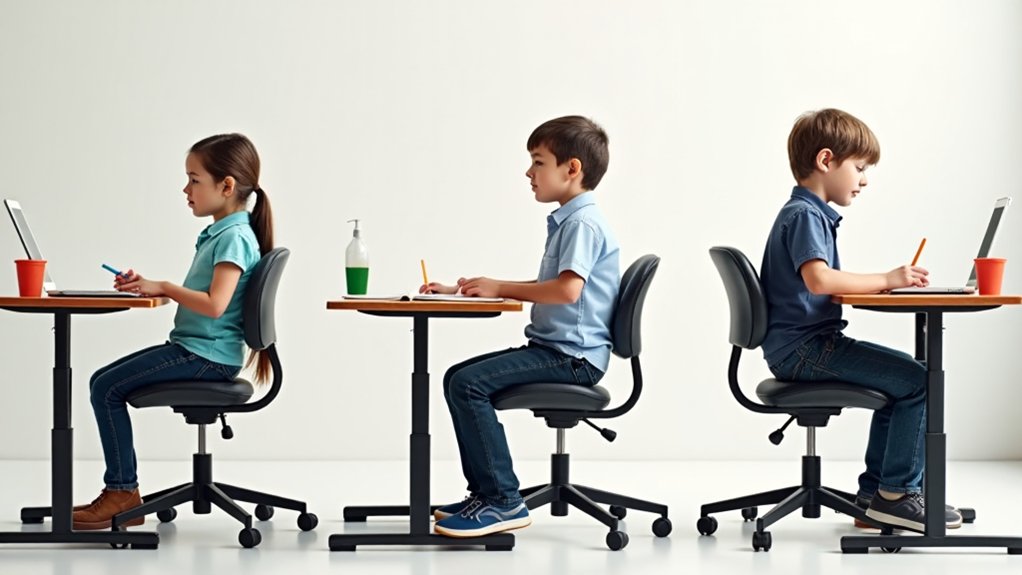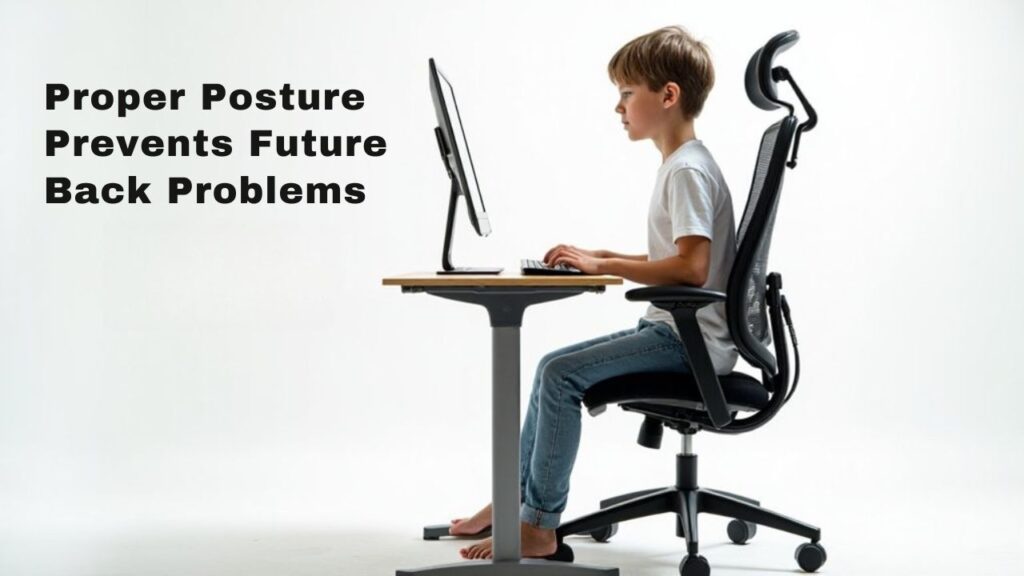How Can Ergonomic Chairs Help Your Child?
You’ve probably noticed your child slouching more during homework time, complaining about back soreness, or constantly shifting around in their chair. While you might think it’s just restlessness, these behaviors signal something more serious—their developing spine isn’t getting the support it desperately needs. As kids spend increasing hours seated for schoolwork and digital activities, the wrong seating can create lasting damage that’ll follow them into adulthood, but there’s a solution most parents overlook. Let’s explore why kids need ergonomic chairs.
Key Takeaways
- Ergonomic chairs provide essential lumbar support to prevent scoliosis and chronic back pain during critical growth years.
- Proper spinal alignment reduces physical discomfort, allowing children to focus better and concentrate during study sessions.
- Adjustable features accommodate growing bodies and individual proportions, ensuring feet rest comfortably and proper positioning is maintained.
- Poor posture habits formed early can lead to lifelong musculoskeletal disorders and chronic pain patterns.
- Comfortable seating enhances learning outcomes by reducing fatigue and maintaining energy throughout the school day.
Supporting Healthy Spinal Development During Growth Years

While children’s bodies undergo rapid changes during their formative years, kids need ergonomic chairs. They can provide the essential lumbar support needed to maintain healthy spinal alignment throughout these critical growth phases.
You’ll find that proper spinal support becomes increasingly important as children spend more hours seated for schoolwork and activities. These specialized chairs feature adjustable components that grow with your child, accommodating their changing height and body proportions.
When you invest in ergonomic chairs for children, you’re actively preventing potential issues like scoliosis and chronic back pain that can develop from poor posture habits.
The adjustable features guarantee ideal positioning, reducing strain on developing muscles and bones. By prioritizing proper spinal support now, you’re helping establish healthy habits that protect their musculoskeletal health throughout life.
Research shows that children should use ergonomic chairs to prevent poor posture during study sessions, as establishing these healthy habits early significantly reduces the risk of developing chronic musculoskeletal issues in adulthood.
Preventing Poor Posture Habits Before They Form

Because children’s posture habits become deeply ingrained during their formative years, you’ll want to prioritize proper seating before problematic patterns take hold. That’s why kids need ergonomic chairs.
When you provide ergonomic seating options early, you’re actively preventing poor posture that could compromise your child’s developing spine. Quality chairs with adequate back support help children naturally maintain alignment while studying or using computers.
This proactive approach means you’ll reduce discomfort that stems from slouching or hunching over desks. The spine support these chairs offer delivers immediate health benefits while establishing foundation habits for lifelong wellness.
Proper chair positioning also helps maintain the spine’s natural curve, which prevents forward head posture that can lead to neck strain and visual discomfort during screen time.
Reducing Physical Discomfort and Strain From Prolonged Sitting

When children spend hours hunched over desks in poorly designed chairs, their developing spines endure unnecessary pressure that can create lasting discomfort.
You’ll notice how prolonged sitting affects their concentration and mood when they’re constantly shifting to find relief. Kids need ergonomic chairs because they are designed specifically to address these challenges. THey do this by providing essential lumbar support that maintains healthy posture throughout study sessions.
You can help children achieve a comfortable seated position where their feet rest flat on the floor, eliminating leg pressure and circulation issues.
This proper alignment doesn’t just reduce the risk of immediate physical discomfort—it also prevents muscle fatigue that typically develops during extended homework sessions. These chairs feature adjustments to grow with your child’s changing body, ensuring continuous support as they develop.
Enhancing Focus and Concentration During Study Time

Physical comfort directly impacts your child’s ability to maintain focus during homework and study sessions. When ergonomic seating solutions provide proper support, they eliminate the physical distractions that come from uncomfortable positioning.
Your child won’t constantly shift or fidget when their chair promotes good posture and reduces strain on developing muscles. This enhanced comfort translates directly into improved concentration.
Without bodily discomfort pulling their attention away, children can dedicate their mental energy to learning rather than managing physical stress. Kids need ergonomic chairs because they encourage natural movement while maintaining proper alignment. By doing so, they allow sustained focus for longer periods.
Research demonstrates that students using ergonomic seating solutions show improved engagement and reduced fidgeting behaviors. By investing in proper support, you’re creating an environment where concentration flourishes naturally.
Ergonomic chairs support the spine’s natural S-curve and lumbar region, promoting healthy posture without conscious effort, which is especially important for children whose musculoskeletal systems are still developing.
Promoting Natural Movement While Seated

While traditional rigid seating forces children into static positions, ergonomic chairs actively encourage the natural movement that growing bodies crave.
These chairs provide comfortable and support through flexible seating options that allow children to shift positions easily, promoting better circulation and reducing physical fatigue.
Flexible seating empowers children to move naturally, boosting circulation and reducing fatigue through adaptive positioning that supports their active learning needs.
Key features that facilitate movement include:
- Adjustable seat height that accommodates growing bodies and maintains proper positioning
- Swivel bases and mobility features that foster peer interaction and active engagement
- Dynamic support systems that encourage core engagement while preventing slouching
Building Foundation for Lifelong Ergonomic Awareness

Beyond the immediate physical benefits, introducing children to ergonomic chairs creates a powerful foundation for understanding how their environment affects their well-being.
When you teach kids about ergonomic principles early, you’re fostering awareness that extends far beyond childhood. They’ll develop instinctive habits of maintaining proper posture and recognizing when their workspace doesn’t support healthy development.
This knowledge empowers children to advocate for their own comfort in classrooms, libraries, and future workplaces. You’re helping them understand the connection between seating choices and health outcomes, reducing their risk of developing musculoskeletal disorders later in life.
Research shows that proper spinal alignment from ergonomic seating reduces muscle pain and strains while encouraging healthier sitting habits that benefit children throughout their developmental years.
Addressing Individual Body Size and Developmental Needs

This ergonomic awareness becomes particularly important when you consider how dramatically children’s bodies change during their developmental years.
While standard chairs use one-size-fits-all approaches, ergonomic chairs accommodate each child’s unique proportions through adjustable heights and customizable features that grow with them.
Children’s developmental needs require specialized attention to prevent musculoskeletal issues before they start.
Here’s how ergonomic seating addresses individual requirements:
- Adjustable heights guarantee feet rest comfortably on floors regardless of leg length
- Proper lumbar support aligns with each child’s natural curvature variations
- Customizable positioning adapts to different torso sizes and growth spurts
When you provide ergonomic chairs that match individual body proportions, you’re supporting healthy spine development during critical growth periods.
This personalized approach reduces physical distractions and promotes improved focus, helping children concentrate better on learning.
Additionally, selecting chairs with adjustable features like armrests and lumbar support ensures proper posture development as children spend increasing amounts of time seated for educational activities.
Minimizing Risk of Future Musculoskeletal Problems

Since poor posture habits formed during childhood often persist into adulthood, investing in ergonomic chairs now can prevent serious musculoskeletal disorders down the road. You’re protecting children from developing chronic back pain and other serious complications by prioritizing good posture early.
| Without Ergonomic Chairs | With Ergonomic Chairs |
|---|---|
| Poor spinal alignment develops | Proper spinal alignment maintained |
| Higher risk of scoliosis | Reduced strain on developing spine |
| Chronic pain patterns form | Healthy posture habits established |
When you choose ergonomic chairs for children, you’re actively investing in their long-term overall well-being. These chairs reduce strain on developing bodies during critical growth years, helping establish healthy posture habits that’ll serve them throughout life. Your proactive approach today prevents tomorrow’s problems. Remember that adjustable features are essential to accommodate children’s varying body sizes and heights as they grow.
Creating Optimal Learning Environment at Home and School

While protecting children’s long-term health remains paramount, the immediate benefits of ergonomic chairs become apparent when you examine how they transform learning spaces.
These specialized seats promote good posture while reducing strain, creating an environment where children can truly thrive academically.
Comfortable seating directly impacts learning outcomes by:
- Enhancing focus – When discomfort isn’t distracting students, they can concentrate fully on lessons and assignments.
- Supporting natural curvature – Proper spinal alignment prevents fatigue during extended study sessions.
- Reducing risks associated with poor posture – Students maintain energy and alertness throughout the day.
Research demonstrates that ergonomic chairs can enhance productivity by up to 40% with proper lumbar support, making them essential tools for developing students’ academic performance.
Frequently Asked Questions
Why Ergonomics Is Important for Kids?
You’ll protect children’s developing spines and prevent future back problems by prioritizing ergonomics. Proper support enhances their focus, reduces fatigue, and establishes healthy posture habits that’ll benefit them throughout their lives.
Do Kids Need Ergonomic Chairs?
Like knights needing proper armor, you’ll want ergonomic chairs for kids since they’re developing rapidly. You’re supporting their spine alignment, preventing future back problems, and helping them focus better during study sessions.
Why Are Ergonomic Chairs Important?
You’ll protect children’s developing spines and promote proper posture with ergonomic chairs. They’ll reduce discomfort, enhance focus during study time, and help kids develop healthy sitting habits that’ll prevent future musculoskeletal problems.
Why Should Kids Have Chairs?
Studies show 85% of children develop poor posture habits by age 12. You’ll help kids avoid lifelong back problems by providing proper chairs that support their growing spines and encourage healthy sitting habits during essential developmental years.
Conclusion
You’ve learned how ergonomic chairs support your child’s developing spine, prevent poor posture, and create an ideal learning environment. Remember, an ounce of prevention is worth a pound of cure—investing in proper seating now protects against future musculoskeletal problems while enhancing focus and concentration today. Don’t wait until discomfort becomes chronic pain. By choosing ergonomic seating that adapts to your child’s individual needs, you’re building healthy habits that’ll benefit them throughout their entire life.

I am a retired software engineer with experience in a multitude of areas including managing AWS and VMWare development environments. I bought a relative a mini-PC a year ago and have become passionate about the technology and its potential to change how we deploy software.

